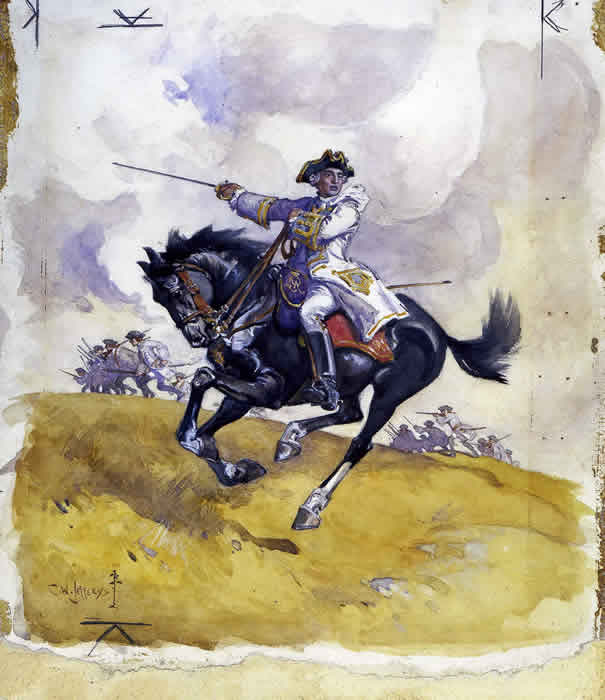

BATTLE OF THE PLAINS OF ABRAHAM
The Battle
During the movements of the French troops, and while they were positioning themselves on the battlefield, several militiamen and colonial troops harassed the British on their flanks. These skirmishes caused casualties on both sides.
Meanwhile, Montcalm analyzed the situation and concluded that he should not give the enemy enough time to gain back strength, otherwise it would be impossible to dislodge the British troops. Moreover, a retreat inside city walls was not a solution, since he considered that the fortifications would not hold if there was a siege. In his mind it was clear that he must attack right then and there.
It was therefore around 10:00 a.m. that the General ordered the attack. The troops, divided into three lines, went into action: the first line was made up of regulars, the second one of militiamen recruited into the regiments, and the third was also made up of regulars. Montcalm's decision to incorporate a militia corps into each land forces regiment proved catastrophic: the line came apart very rapidly. A stone's throw from the enemy, the soldiers of the second line fired without the order to do so. The third rank then fired, followed by the first.
Faced with this confusion, the British soldiers remained impassive. Their two cannons fired grapeshot, but the soldiers did not budge. Obeying the orders of their General, they formed a line on two rows, which allowed them to cover more surface then the usual three119, and they loaded their guns with two bullets to increase the destructive power of their fire. The order to fire only came when the enemy was at a distance of approximately 40 yards (a little over 35 metres).
At the proper time, the first British salvo was heard. Unlike what is often claimed in history books, not all soldiers fired that first salvo, only those belonging to the 43rd and 47th regiments – the ones in the centre of the line120. Subsequently, the other regiments opened fire. The first line of the French Army fell, and Sénezergues, Saint-Ours and Fontbonne (French officers) were shot dead. A counterattack was sounded: Monckton was pierced by a bullet and Carleton was wounded in the head121. The British soldiers advanced a few paces to emerge from the smoke and carried a second salvo, which completed the work. Montcalm's men beat a retreat. The battle had lasted less than half an hour.
And what of Bougainville and his men on September 13? Why had they not rejoined the rest of the troops and taken the British army from behind? Very few sources reveal what happened with this detachment on September 12 and 13. Some historians suggested that Bougainville could have followed a British ship as far as Pointe-aux-Trembles upstream from Cap-Rouge. However, this pretence on the part of the British Navy is not attested by any sources122. According to a letter the Colonel himself wrote to Bourlamaque five days after the battle, he apparently had only been informed of the landing at 8:00 a.m. Be that as it may, the Samos and Anse-au-Foulon posts were under his command, and he should be held responsible for his failure to counter the landing and reach the battlefield on time123.
It was only after the battle was over that Bougainville and his men came near the battlefield. To face them, Townshend, who was now in command of the British army since Wolfe's death and Monckton's injury, had the two regiments remaining on the Plains take up their positions. Although Bougainville did not attack, his presence forced Townshend to hold his position and prevented him from chasing after the French Army, which was retreating on the other side of the St. Charles River.

